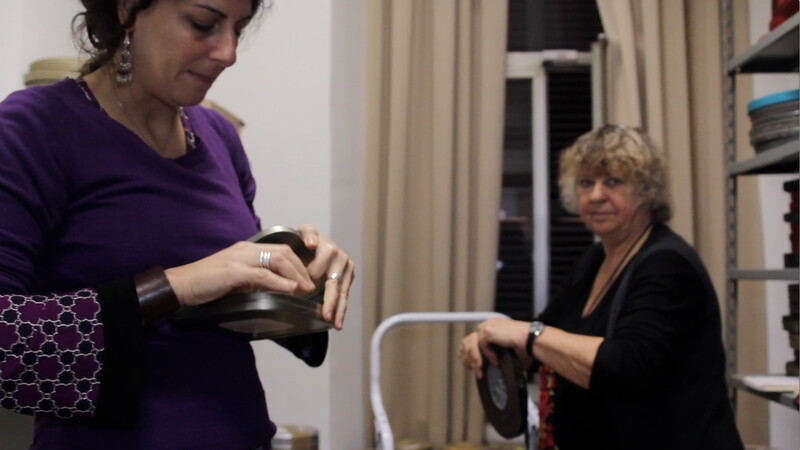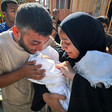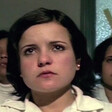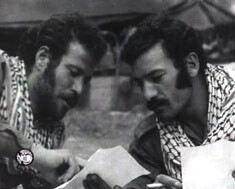The Electronic Intifada Chicago 17 November 2013

Emily Jacir and Monica Maurer at the Audiovisual Archive of Workers’ and Democratic Movements in Rome. (Photo by Johnny McAllister, courtesy of Emily Jacir)
Thirty-three reels of film dating from the 1970s which document the Palestinian liberation movement in Lebanon are currently being digitized in Rome. Included are nearly a hundred hours of footage recorded by Mustafa Abu Ali and Jean Chamoun and cameramen with the Palestine Liberation Organization’s film unit in the Tel al-Zaatar Palestinian refugee camp in Beirut. (Watch videos of footage edited together from the reels at the bottom of this page.)
The footage documents daily life in the camp, the siege and the aftermath of the massacre in 1976, featuring the testimony of survivors and fighters with the Palestinian resistance. For several months that year, right-wing Christian militias laid siege on the camp, killing thousands of civilians.
The footage, most of it the rushes left over from the film Tel al-Zaatar by Abu Ali, Chamoun and Pino Adriano, is a record of a history that has been erased, of a refugee camp that was wiped off the face of the earth. It is the only film that has been made about the massacre.
Is is also an artifact of Lebanon’s civil war, as the footage had to be smuggled out of the country by Abu Ali after the only facility where they could process and edit the film was destroyed in the fighting.
The film is also a product of the internationalist tradition of solidarity and revolutionary cinema. Abu Ali and Chamoun, who came to Rome for several months for post-production, edited the film in partnership with the Italian Communist Party’s film unit, Unitelefilm. Tel al-Zaatar was shown at summer festivals organized by Unita, the Communist Party newspaper founded by Antonio Gramsci, in cities and villages all over Italy.
Forgotten
The digitization project is being painstakingly undertaken by Monica Maurer — who worked with the PLO’s film unit to make several films on the Palestinians in Lebanon during the period of Tel al-Zaatar — and internationally-renowned Palestinian artist Emily Jacir.
In an interview over Skype on the anniversary of the most notorious Palestinian tragedy in Lebanon — the 1982 massacre in Beirut’s Sabra and Shatila camps — Maurer and Jacir explained what prompted them to drop everything and go through these reels.
The film reels had been sitting in a deposit of the Audiovisual Archive of Workers’ and Democratic Movements (AAMOD), which evolved from Unitelefilm, outside of Rome for nearly four decades, untouched and largely forgotten.
“I received this emergency phone call from Monica last January because she had been telling me for the last several years about their [AAMOD’s] audio visual history that they have, [and] that there’s no funding — how are they going to protect all these films, documents, etcetera,” Jacir said. “And finally in January they [AAMOD] got this amazing announcement that they could host their archive inside the Italian state archive.”
But before the film reels would be transferred to the state archives, where they would be preserved but not generally accessible or even known to anyone who didn’t visit the Rome facility, Maurer wanted to have them digitized and made available to the families of Tel al-Zaatar.
Visual memory
“I’ve been continuing to go to Lebanon in the last 12 years or so, since 2000,” Maurer explained, adding that this is the first year she didn’t attend the Sabra and Shatila anniversary commemoration. “So there I met again a lot of people, not only Sabra and Shatila [survivors] but also [those] who had been victims of the Tel al-Zaatar massacre or children or relatives of survivors from Tel al-Zaatar …
“There was a fantastic initiative by the families of Tel al-Zaatar to build an Internet network … where relatives or children or friends [of Tel al-Zaatar victims and survivors] are connecting to each other in order to exchange testimonies, memories, pieces of remembrance. And having met again those people I had met thirty years before … I thought it would be very important for them to have this visual memory of their own history.
“So that was the challenge and the well, if you want, duty — as an homage to the people who had suffered and who died there. I felt that it was part of the collective Palestinian memory and that is why it should be made accessible for everybody. And that’s why I called Emily … we are both working with the concept to conserve memory,” Maurer said.
“Tel al-Zaatar was one of the biggest camps in Lebanon,” she added. “It was not exclusively Palestinian — there were a lot of Lebanese, and also Syrians, Turks, Kurds and so on. It was pretty mixed but of course a great majority, I would say 70 to 75 percent, were Palestinians.”
“It had very lively commercial activity,” Maurer added, comparing it to Nahr al-Bared, the camp north of Tripoli which was destroyed during and after fighting between salafi militiamen and the Lebanese army in 2007, displacing 30,000 Palestinian residents.
“And there was very good relations between the Lebanese and the Palestinians, or the Palestinians and the non-Palestinians, in this camp. It was also a camp with a very high level of political consciousness,” Maurer said.
“At the peak of the civil war it was the objective of the Phalange [a right-wing Christian militia] to attack and destroy Tel al-Zaatar and it was besieged for months and months, having only two doctors for about 80,000 or at this point maybe 60,000 people inside. Those were Dr. Youssif al-Iraki and Dr. Abdelaziz al-Labadi, who did not leave the camp until the evacuation by the Red Cross on 12 August 1976.”
Precious
In addition to their historical value, the Tel al-Zaatar rushes are particularly precious considering that they are material which wasn’t included in the finished work, often thrown away upon completion of a film.
The rushes are all the more priceless because the PLO film unit archive went missing from Beirut following Israel’s invasion in 1982, its fate still unknown. What works remain from this period are scattered around the world and there is no centralized archive or database of surviving films.
Much of Palestine’s cultural property has been stolen and destroyed, “from the books and libraries looted from cities across Palestine in 1948, to the confiscation of the Palestine Research Center’s entire Beirut archive in 1982 (restored in 1983, following international pressure, minus the film collection), to the seizure of documents and archives from the Orient House in Jerusalem in 2001,” as Jacir recently summarized for Creative Time Reports.
“Part of the Israeli strategy to erase, to uproot the Palestinian people, is to erase their memory and their roots, their cultural and national identity. And this is why the conservation of oral history and audiovisual testimony to this history is so important,” Maurer stated during our interview.
This motivates Maurer and Jacir to see this project through, however tedious it may be.
Jacir explained that the process “began first and foremost with Monica going to their [AAMOD’s] storage container space far from the center Rome in the freezing cold of winter to bring these reels to AAMOD.”
“The first thing was to open them and see what was salvageable and what wasn’t, which involved a lot of horrific fumes,” she added.
“We had to wear masks,” Maurer interjected.
Obsession with details
Most of the footage doesn’t have sound to accompany it; only the sound that a filmmaker knew would be used in the edited film was transferred to 16mm magnetic tape and synchronized with the footage it refers to. The fragile nature of the material means that the sound reels are more likely to be damaged.
“It’s difficult for me because I never worked in film in that way and it’s such an arduous process,” Jacir said.
“Also it’s difficult for me as an artist working in there as well. You know my work and my obsession with details; I can find a story in a grain of dust. So when they say this is destroyed, we have to throw it out — they’re throwing things in the garbage and we’ve had fights about this,” she added, laughing.
“She took from the garbage even pieces as big as a fingernail!” Maurer exclaimed.
“Some of the footage which is deemed unimportant to me feels so important and so precious, and the disintegration of the film itself is something I’m really interested in as a physical material. I’ve been taking all that out of the trash,” Jacir said.
“I have a visual approach to film, she has a physical, sensual approach to it,” Maurer added.
“Today was hard because I realized how far off we are. We’ve sent five reels in to be digitized; these are reels which unfortunately don’t have sound. But we still have a long, long way to go, especially with the sound,” Jacir said.
“We are maybe at 10 percent,” Maurer added.
“Then again we just got this amazing news that the Khalid Shoman Foundation is going to fund the digitization of everything else. There was a long period in which we didn’t work because we didn’t have the funding,” Jacir said.
“And we couldn’t even pay anybody to. The restoration of the sound and partially the pictures … you need a professional for it. Of course nobody is prepared as we are to work for nothing,” Maurer explained.
Hope and pride
“We have such little access to what Palestinians in Lebanon lived, what they organized, what happened; it was incredible in April when this group of ten Gazans came to AAMOD to work with us,” Jacir said, referring to young video artists and filmmakers who participated in a workshop on preservation techniques and viewed three revolutionary films: Tel al-Zaatar and Al-Fatah Palestina, and AAMOD president Ugo Adilardi’s La lunga marcia del ritorno (The Long March of Return).
It was revelatory for both the Gaza artists as well as Jacir to hear Maurer describe that period of the Palestinian liberation movement which she filmed in the late 1970s and early ’80s. Maurer documented the social movements and the PLO’s infrastructure in the camps, such as hospitals and clinics, schools, vocational training centers and clinics.
“That was my main subject, to show, in different contexts, the embryo of a future state — what we then called a state without land. A society which was oriented toward social change, social justice, participation. The active role of women in the political, cultural and social affairs. The enormous stressing on education; education was one of the main values then, because it was clear that the only way out of the disaster of the refugee camps is education, is knowledge.”
This emphasis on education, including professional trades, “would give you a possibility to survive … and even build a family, to live a life in dignity. And this is exactly that what the Israelis in 1982 wanted to destroy; they wanted to physically eliminate the people, to erase the PLO from Lebanon,” Maurer explained.
“They bombarded the cemeteries, can you imagine! … It was such a concentrated aggression to uproot the Palestinian presence … So I felt that it was very important to show the capacity, the revolutionary energy and creativity to build an infrastructure that would guarantee not only social change but also a better life and hope in the Palestinian society.”
Despite the terrible situation for Palestinians in Lebanon, the enormous losses of life, and “the continuous bombardements,” Maurer said, “there was hope, and there was pride.”
“When I see her footage of the social structures, the political structures that existed in the camps when she filmed, I’m just shocked because I can’t imagine that today,” Jacir said.
“Monica lived that period in Lebanon and I didn’t. Monica knows that history and filmed that history, so her engagement with the material is very different than mine,” Jacir added. “And knowing the history of not just our film archive and so many other archives which have been eradicated, the preciousness that I have from every section [of Tel al-Zaatar] comes from that, from not having lived it but also just wanting to have all of this be accessible to everybody.”
Towards that end, the digitized footage will be given as a gift to the Institute of Palestine Studies, where it can be made available to researchers and filmmakers. “I think it’s very important that people know that there is some material to work on and that they get hold of it,” Maurer said.
“It is very important, particularly in a time of loss of hope, to give this feeling that no struggle, if you have a clear aim, is too heavy to be fought,” she added. “I do believe that whatever hardship you go through and whatever you lose, that in the end this archaeology of cultural, historical heritage is something that makes a difference.”
“It is very important to keep this very particular, I would say glorious, page of the Palestinian history in Lebanon,” Maurer concluded. “It was a moment of justified pride; it was a moment of constructivity; it was a moment of hope and a moment of compassion and participation of all the people. These are the only values that can give us hope for the future.”
Watch videos of footage edited together from the Rome reels
Maureen Clare Murphy is managing editor of The Electronic Intifada.





